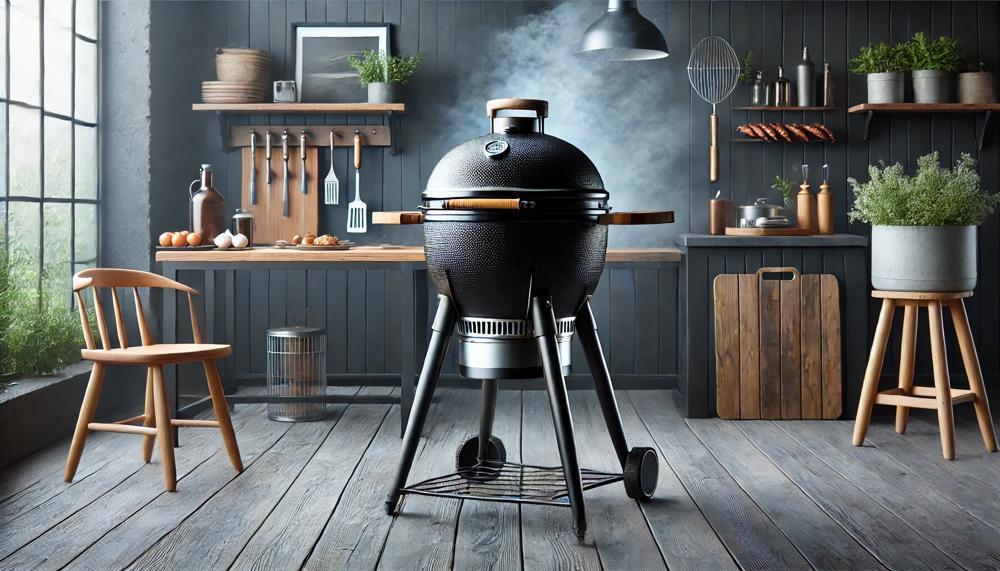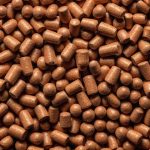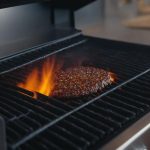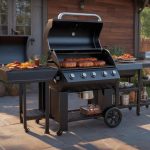Yes, it’s frustrating when your Traeger grill refuses to hit that perfect 450°F mark. If you’re wondering why this happens, you’re not alone. The good news is that this issue is usually fixable with some basic troubleshooting and maintenance.
First, let’s address the core reasons why your Traeger might struggle to reach 450°F. It often boils down to airflow issues, part malfunctions, or pellet quality. Here’s a quick rundown of the main factors:
- Regular Cleaning: Ash buildup in the firepot can restrict airflow, preventing the grill from heating efficiently.
- Part Inspection: Components like the firepot, induction fan, and RTD probe can wear out and need replacing.
- Chimney Cap Adjustment: Proper airflow through the chimney is crucial; adjusting the cap can make a big difference.
- Pellet Quality: High-quality pellets ensure consistent heating, while lower-grade options might not burn as effectively.
- Preheating: Giving your grill 20-30 minutes at 350°F before cranking it up can help it reach higher temperatures smoothly.
- Lid Management: Keeping the lid closed during preheating and cooking helps maintain the desired temperature.
By following these steps, you can often resolve the heating issues and get your Traeger grill back to performing at its best. Ready to dive into the details? Let’s break down each point and explore how you can optimize your grilling experience.
Stay tuned as we walk through practical solutions to keep your Traeger sizzling hot and ready for any BBQ challenge.
Contents
Traeger Grill Not Heating Up?
If your Traeger grill is not heating up, here’s what you can do to troubleshoot and resolve the issue:
- Check Pellet Quality: Ensure your pellets have a glossy appearance and snap when broken. Poor-quality pellets affect heating efficiency. Replace them if necessary.
- Inspect Auger and Firepot: Verify that the auger is turning and feeding pellets into the firepot properly. Clean out any excess debris from the firepot to maintain airflow.
- Verify Hot Rod and Components: Check the hot rod, fuses, and induction fan for any malfunctions. These components are crucial for igniting and maintaining heat.
- RTD Temperature Sensor: Inspect the RTD temperature sensor to ensure it’s functioning correctly. This sensor regulates the grill’s temperature accuracy.
- Chimney Cap Adjustment: Adjust the Traeger chimney cap for optimal airflow. Poor airflow can hinder heating performance, especially at higher temperatures.
- Pellet Moisture Levels: Ensure your wood pellets are dry. Moisture can prevent them from burning efficiently and reaching high temperatures.
- Preheating and Lid Use: Preheat your Traeger grill for 20-30 minutes at 350°F before increasing the temperature. Keeping the lid closed helps maintain heat and achieve desired cooking temperatures.
Traeger Not Heating Up To 300°F?
If your Traeger grill isn’t reaching 300°F, the issue often stems from a malfunctioning RTD (Resistance Temperature Detector) probe or the auger fan, both critical for proper temperature regulation.
First, verify that the RTD probe is clean and securely connected, as it plays a pivotal role in sensing and relaying the grill’s internal temperature to the control system.
Secondly, check the auger fan, responsible for maintaining airflow and flame strength within the grill, ensuring it’s operational and not obstructed.
Additionally, environmental factors and fuel quality can significantly impact your grill’s ability to heat efficiently. Ensure that the grill is sheltered from wind, which can dissipate heat and prevent the grill from reaching the desired temperature. Also, always use fresh, dry wood pellets, as moisture can compromise their heating efficiency.
Below is a troubleshooting table that outlines common issues and their solutions to help your Traeger reach the optimal temperature:
| Problem Area | Potential Issue | Solution |
| RTD Probe | Dirty or faulty | Clean or replace the RTD probe. Check connections for security. |
| Auger Fan | Blocked or malfunctioning | Clear any blockages and ensure the fan operates smoothly. |
| Environmental | Excessive wind | Position the grill in a more sheltered location. |
| Pellet Quality | Moist or old pellets | Replace with fresh, dry pellets. |
By addressing these areas, you should be able to resolve heating issues and enjoy consistent cooking temperatures.
Traeger Not Heating Up To 450°F?
The issue of your Traeger grill not heating up to 450°F can stem from several factors. First, confirm that your grill is plugged in and receiving sufficient power. If it’s struggling to reach higher temperatures, there might be underlying issues with components like the RTD Probe or Auger Fan.
Ensure the RTD probe is clean and securely connected, as any buildup or loose connection can affect temperature regulation. Check the auger fan for any obstructions that could hinder pellet feeding and combustion, thereby limiting heat production.
Moreover, external conditions such as wind can significantly impact your Traeger’s ability to reach higher temperatures. Position your grill in a sheltered spot to mitigate wind interference. Additionally, using fresh and dry wood pellets is crucial for optimal heat output. Wet or old pellets can burn less efficiently, preventing the grill from achieving the desired temperature.
If your Traeger still fails to reach 450°F after addressing these factors, consider a systematic inspection of each part. This approach helps identify any hidden issues affecting performance. By troubleshooting these areas, you can enhance your Traeger’s heating capabilities for a better grilling experience.
| Common Issue | Possible Solution | Additional Information |
| Power Supply | Check if Traeger is plugged in and receiving adequate power. | |
| RTD Probe or Auger Fan Issue | Ensure RTD probe is clean and properly connected; inspect auger fan for blockages. | Failure to reach 300°F could indicate problems with these components. |
| External Conditions | Shield grill from wind; use fresh, dry wood pellets. | External factors often hinder reaching higher temperatures. |
| Systematic Inspection | Inspect each part methodically if desired temperature is not achieved. | This helps identify hidden issues affecting performance. |
Barbecue Tips and Guides – Kept Simple
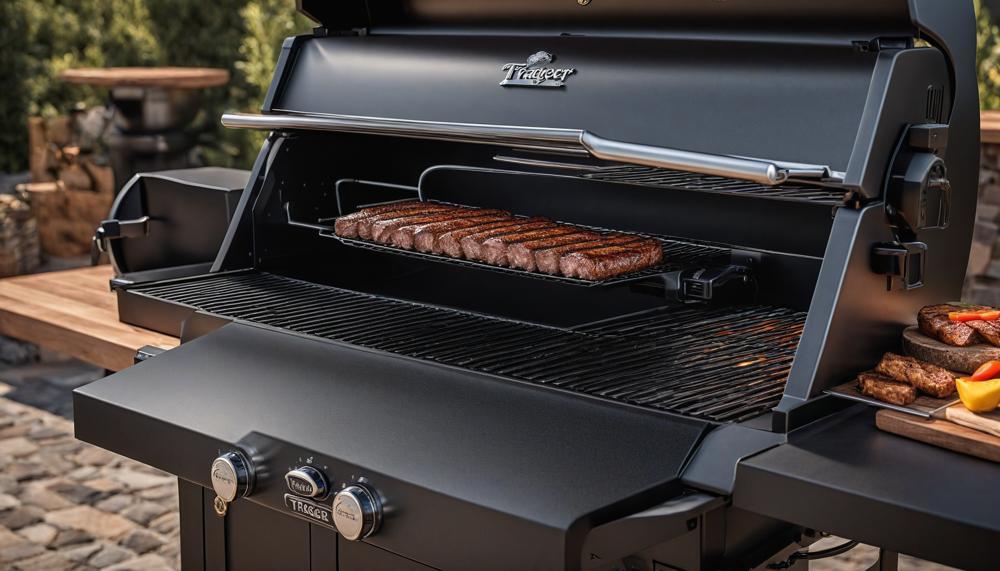
Achieving high temperatures such as 450°F with your Traeger grill involves specific maintenance and troubleshooting practices to ensure efficiency and optimal performance. Below is a guide on how to maintain your grill and resolve common issues.
Regular Cleaning
Keep your grill clean to prevent ash from blocking the airflow necessary for high temperatures. Specifically, the firepot should be emptied of ash after each use.
Inspect and Replace Vital Components
| Component | Function | Signs of Wear |
| Firepot | Crucial for pellet ignition | Excessive corrosion or holes |
| Induction Fan | Facilitates airflow | Noisy operation, reduced speed |
| RTD Probe | Temperature monitoring | Inaccurate readings |
Chimney Cap Adjustment
Adjust the chimney cap to ensure it is not too open or closed, which can restrict or allow excessive airflow, respectively, affecting temperature control.
Use High-Quality Pellets
Only use high-quality Traeger wood pellets, as poor-quality pellets burn inefficiently and affect the grill’s ability to reach and maintain high temperatures.
Preheating Strategy
Always preheat your grill at 350°F for about 20-30 minutes before ramping up to higher temperatures. This step is essential for stabilizing the internal environment of the grill.
Maintaining Temperature
To maintain temperature, especially when aiming for higher settings, restart your grill with the lid closed to minimize heat loss during the start-up phase.
Implementing these tips will help ensure your Traeger grill performs optimally, reaches desired temperatures efficiently, and extends its lifespan.
Regular maintenance, coupled with careful use of recommended accessories and supplies, is key to enjoying consistent high-temperature grilling.
Conclusion
Struggling to reach that elusive 450°F on your Traeger grill can be like trying to solve a complex puzzle. Fortunately, with a bit of know-how and some straightforward maintenance, this puzzle becomes easier to solve. The root of the issue often lies in a combination of factors such as airflow complications, worn-out components, or subpar pellet quality.
To coax the best performance out of your Traeger, start with regular clean-ups to keep ash from choking the airflow, and make sure all crucial parts like the firepot and induction fan are in top shape. Also, check that the pellets you use are of high quality, as inferior pellets won’t burn hot enough to achieve high temperatures. Adjustments to the chimney cap can further enhance airflow, essential for reaching higher temperatures.
Remember, the simple act of preheating your grill and managing the lid correctly can significantly improve your Traeger’s ability to hit and maintain 450°F. Treat these steps as your grill’s recipe for success—by combining these ingredients, you’re setting the stage for flawless grilling sessions that hit the mark every time.

